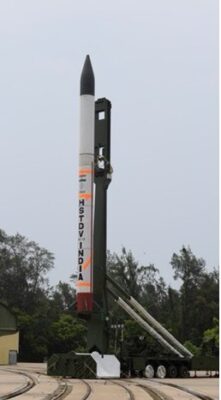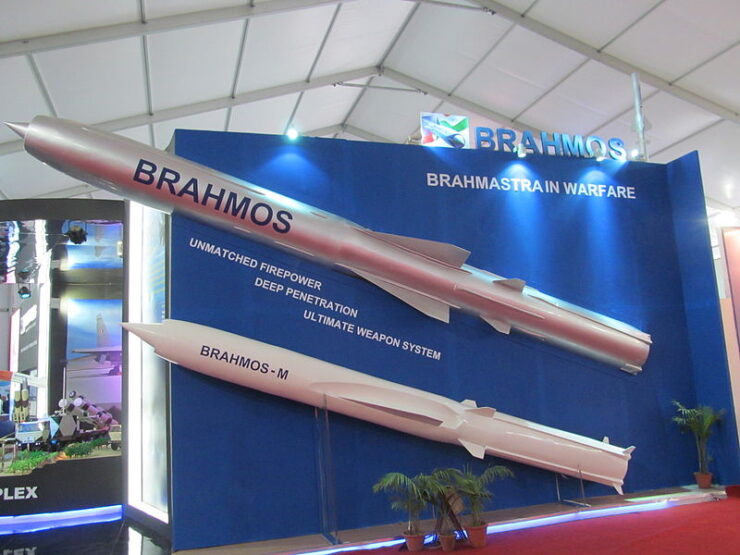
On September 7, India successfully flight tested a hypersonic technology demonstrator vehicle (HSTDV), becoming the fourth country after the US, Russia and China to do so. According to the Defence Research and Development Organisation (DRDO), the test, which was conducted off the Odisha coast, saw the scramjet-powered vehicle sustain Mach 6 (six times the speed of sound or 7,350 kph) during the course of its 22 second flight at an altitude of 30 km.
To place the performance in perspective, the HSTDV covered the equivalent of a marathon in 22 seconds. If weaponised, a hypersonic missile launched by the 3rd Self-Propelled Anti-Aircraft Regiment based in Firozpur would have the capability to bring down an F-16 over the Sargodha air base in Pakistan in two minutes. The Pakistani pilots may not even have the time to eject, let alone say their prayers.
Hypersonic missiles are capable of travelling over 5,000 kph, which gives them tremendous kinetic energy. To illustrate, a 500 kg projectile travelling at Mach 2 will have an explosive power less than half a tonne of TNT, but the same missile with an impact speed of Mach 8 will deliver a TNT equivalent of 3.5 tonnes.
Also, unlike ballistic missiles, hypersonic projectiles are capable of manoeuvring multiple times in their trajectory. These features enable such missiles to penetrate most missile defences and to considerably reduce the response time for a nation under attack.
There are two primary types of hypersonic weapons. The first, hypersonic glide vehicles (HGVs) are launched by rockets into the upper atmosphere. Unlike ballistic missiles that travel in a parabolic – and predictable – path to the target, HGVs glide through the stratosphere after they are released from their missile boosters.
The glide phase allows HGVs to accelerate to hypersonic speeds and manoeuvre aerodynamically to evade interception. HGVs are unpowered vehicles that are designed to produce lift that is equal to their weight to keep them aloft at hypersonic speeds. They travel outside the altitude and speed envelopes of most modern air and missile defence systems.
Terminal air defence systems would be challenged because an HGV can vary its impact point and associated trajectory throughout its flight time. HGVs also fly at lower altitudes compared with ballistic missiles.
The second type of weapon is the hypersonic cruise missile (HCM), which is powered all the way to its target by rockets or high-speed jet engines. Basically, an HCM is a cruise missile that operates at hypersonic speeds. (For comparison, the BrahMos cruise missile travels at 3,000 kph).
Cruise missiles are already difficult to counter because of their unpredictable trajectories, low profiles and below the radar flight. Even the slower, subsonic ones such as the Tomahawk (which has an operating speed of 900 kph) are deadly. For instance, in the 1991 Gulf War, it took 80-odd Tomahawks just four hours to destroy Iraq’s C3 (command, control and communications) systems that had been built over several years and at considerable cost. The additional speed provided by an HCM will only shorten response times.
-Rand report titled ‘Hypersonic Missile Nonproliferation’
Hypersonic v/s ballistic
For more than half a century, the world has lived with the doctrine of Mutually Assured Destruction, or MAD. The trajectory of most ballistic missiles give early warning systems a window of 15-30 minutes to verify if it’s a massive missile launch or a false alarm due to a meteor shower, an unusual cloud formation or a computer glitch. If it’s indeed a doomsday scenario, you say your prayers and launch a counter strike, and pretty much everyone ends up dead. Bizarre as this strategy is, MAD has effectively prevented the outbreak of World War III.
Hypersonic technology is disruptive because it could upend this balance. According to Aviation Week & Space Technology, “An HGV can execute a pull-up manoeuvre after entering the atmosphere and approach its target in a relatively flat glide. It will therefore be detected later than a ballistic warhead; there is less time to react to it or to shoot at it again after a miss. Because the HGV can manoeuvre aerodynamically, it is much harder to hit — the defensive missile must be able to out manoeuvre it —and it can be guided with precision onto its target. Gliding extends the missile’s range, so that the relatively vulnerable mid-course phase of its flight can occur farther from the target and its defences.”

The US is currently the leader in space-based weapons technology. Its hypersonic glide programme is intended as a key component of its Conventional Prompt Global Strike system, which aims to hit any target on Earth in less than 60 minutes.
American strategists have proposed that hypersonic weapons could be used for “conventional prompt global strike” without the risk of being mistaken for a nuclear attack. For instance, armed with conventional warheads, hypersonic missiles could destroy the enemy’s critical C3 (command, control and communication) nerve centres, airfields, aircraft carrier battle groups, armour concentrations, missile launchers and other strategic assets.
But that’s probably not where the conflict would end. For, the temptation to escalate would be too great. Before the enemy knows what hit him, a second volley of nuclear-warhead carrying HGVs could fly in under the radar – that are only equipped to detect ballistic missiles – and deliver the death blow.
Because hypersonic vehicles could do the rendezvous in a fraction of the time taken by ballistic missiles, it gives the other side little warning time. One is faced with the dilemma of launch or die. In the coming decades, hypersonic technology could become a scare word like atomic bombs were during the Cold War.
Says a Rand report titled ‘Hypersonic Missile Nonproliferation’, “We believe that the unpredictable trajectories, resulting in target ambiguity, and the ability to penetrate most defences, will affect some nations’ defence postures and increase instability in some regions. We note that these new missiles will almost exclusively affect nations that are otherwise equipped with effective defences against ballistic missiles. This may be a substantial number of nations over the coming decades.”
Russia-China nexus
The Russians have been working on hypersonic technology for decades. Therefore, it comes as no surprise that their powerful MiG-31, the world’s fastest fighter aircraft for nearly 40 years, is equipped with the Kinzhal missile. Reportedly a Mach 10 ballistic missile, it can be equipped with either a conventional or nuclear warhead. The worry from India’s point of view is that in the backdrop of the growing intersection between China’s and Russia’s strategic postures and threat perceptions, Russia may be passing on hypersonic secrets to the Chinese. For, there is strong evidence that the two countries may be jointly working on cutting-edge missile programmes.
In a study titled ‘Factoring Russia into the US-Chinese Equation on Hypersonic Glide Vehicles’, the Stockholm International Peace Research Institute (SIPRI) says Russia is a factor that is shaping Chinese hypersonic research. According to SIPRI, two signs point to a Russia-China nexus. One, there are as many as 872 Chinese-language texts on HGVs that mention Russia, constituting 52 per cent of the total number of Chinese articles and papers on hypersonic glide. Secondly, China’s flight test of its DF-ZF hypersonic glide system in April 2016 occurred just days after Russia carried out its own test.

The past 20 years of Russia-China cooperation are beginning to pay off – for the dragon. In June 2020, Chinese scientists claimed a breakthrough with a new generation of long-range, potentially intercontinental hypersonic weapons. According to a report in Global Times, the new scramjet-propelled weapon extends the range of China’s existing DF-17 boost-glide hypersonic weapon by as much as five times, introducing the prospect of turning it into an intercontinental hypersonic missile.
China also has the CM-401 hypersonic anti-ship ballistic missile which flies at a speed of almost 5,000 kph or over four times the speed of sound at a height of 25-100 km. In its terminal phase, it accelerates to almost six times the speed of sound as it approaches the target and is most effective against ships of the size of frigates and above up to a range of 290 km.
The CM-401 could well be a knock-off of the Kinzhal, but even if it is only half as capable as the Russian version, the Chinese missile would still be deadly. Indian Navy Commodore (Retd) Anil Jai Singh writes in the Financial Express that the CM-401 will be available for export. If Chinese weapon export trends are a guide, the first customer could well be its guinea pig – Pakistan.
Currently, India’s massive naval superiority gives it the capability to launch a speedy attack against Pakistan, destroy the Karachi and Gwadar ports, sink the majority of its warships and bottle up the rest of the Pakistan Navy in littoral waters. However, a Chinese Kinzhal in the Pakistan Navy arsenal would dramatically increase the vulnerability of the Indian Navy, especially its large aircraft carriers.
India’s position
Despite a late start, India has made tremendous progress in R&D in hypersonic missile technology. “While India remains behind the United States, Russia, and China in their development, close cooperation with Russia has made India a leader among the second tier of states pursuing hypersonic technologies,” says the Rand report.
India and Russia are currently working together on the hypersonic BrahMos II – the new improved version of the already successful BrahMos cruise missile. The BrahMos II is likely to achieve speeds greater than Mach 7, or seven times the speed of sound.
For all practical purposes BrahMos II is an unstoppable project. One, after India’s entry into the MTCR, the 290 km cap is gone. There are no restrictions on the range or speed of any missile that India can jointly produce with any country. Secondly, BrahMos Aerospace is an India-Russia joint venture, with top Russian and Indian aerospace scientists working together in India.
It has set an established pattern of Russian intellectual capital flowing into India’s aerospace sector. If Moscow places curbs on this technology flow, it will create considerable bad press in India and loss of income for Russia’s cash-starved enterprises.
BrahMos II is reportedly an adaption of Russia’s Zirkon hypersonic missile while the first generation BrahMos is an adaptation of Russia’s Oniks missile. Further, a technology-sharing agreement with Belarus (a close Russian ally) may further spread the diffusion of hypersonic technology.
The DRDO’s HSTDV is India’s parallel effort at building a hypersonic cruise missile using scramjet technology. It is separately researched and funded from BrahMos II and entirely indigenous. The programme’s first wind tunnel test was conducted in 2007 in Israel and the second in Russia in 2009, as India lacked a testing facility with a sufficient cross section.
As well as the HSTDV, the DRDO is developing the Shaurya ballistic missile, a two-stage, solid fuel, surface-to-surface missile. One of the test flights of this missile on November 12, 2008 was a depressed trajectory flight (at Mach 6 and 50 km altitude). The missile is known to have attained speeds of Mach 7.5 during tests.
The seriousness with which India is pursuing this technology can be assessed by the fact that India has built at least 12 hypersonic wind tunnels across the country.
Challenges ahead
The challenges with hypersonic flight are multi-faceted, as travelling at hypersonic speeds generates unprecedented temperatures and turbulence, creating huge destabilising forces. Even as Indian engineers are grappling with these teething problems, the leaders are stretching their lead.
The US, for instance, is not only testing its initial generation of soon-to-be operational hypersonic weapons, but is also moving to the new levels of technical sophistication necessary to reach a new generation of hypersonics, says a June 2020 report in the National Interest.
“Also, looking even farther into the future, Air Force scientists are already looking at early concepts for hypersonic drones or even recoverable hypersonic air vehicles able to attack or conduct forward intelligence, surveillance and reconnaissance missions.”
While developments in the US do not directly impact India, New Delhi must factor in Chinese hypersonic research as well as the very real possibility of Russia passing on the crown jewels of its weapons industry to China. Due to US economic sanctions, Russia’s primary motive is to ensure cash flowing to its defence sector. Also, with the world moving away from oil – Russia’s primary export – Moscow’s dependency on the dragon is only going to increase, not lessen. Therefore, India will have to compete singlehandedly against the Russia-China duopoly.
China recently supplied Pakistan with CM-400AKG high-supersonic (Mach 4) rocket-powered cruise missiles. While one can speculate that this is an attempt to balance the Russian-Indian cooperation on the BrahMos family of missiles, it potentially suggests a future in which supplier states compete in offering hypersonic missiles to their friends and allies.
In this backdrop, a massive multidisciplinary effort is required to ensure that India does not lag behind in this critical sector. Only when India graduates to the HGV and HCM stage will it have the capacity to counter Chinese adventurism.
Hypersonic missiles can also be used as leverage to ensure the dragon’s good behaviour. That is, prevent Beijing from exporting advanced weapons to Islamabad.
India’s traditional reticence towards arms exports is hopefully a thing of past, never to return. Since New Delhi has tentatively offered the BrahMos for export, it is possible the BrahMos II will also be put on the market. In an article titled ‘Analysis and Localisation of Communications Emitters in Strategic and Tactical Scenarios’, in Naval Forces, Ulla Uebler writes: “Thus far, both Russian and Indian officials have said that they do not intend to export BrahMos II, but it is reasonable to expect that the decision is subject to change.”
Simply by threatening to supply these missiles to Vietnam, the Philippines and Japan – countries that are feeling the dragon’s pressure – India can stop the Chinese from running amok in its neighbourhood. But if the reckless communists do introduce hypersonic weapons on India’s borders, New Delhi should have the capacity to deploy these disruptive missiles all across the Himalayas and in the enemy’s backyard, the South China Sea.
–The writer is a globally cited defence analyst. His work has been published by leading think tanks, and quoted extensively in books on diplomacy, counter terrorism, warfare and economic development. The views expressed are personal and do not necessarily reflect the views of Raksha Anirveda








